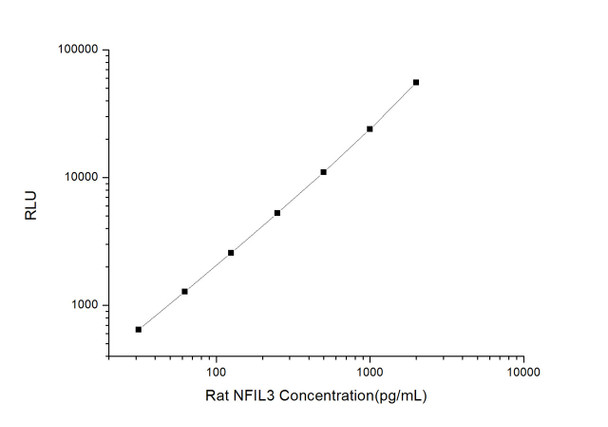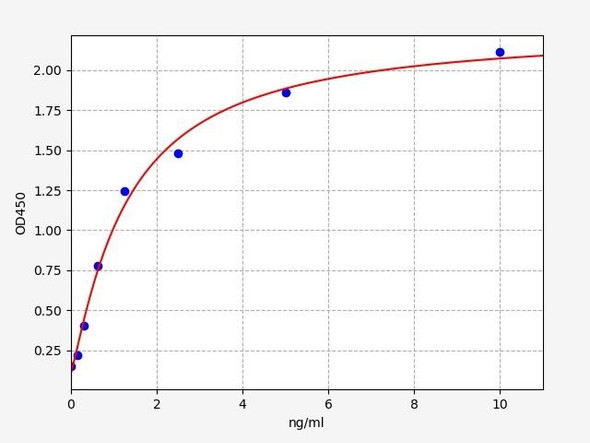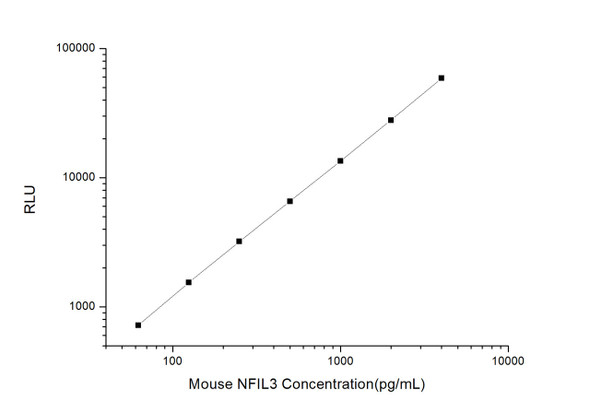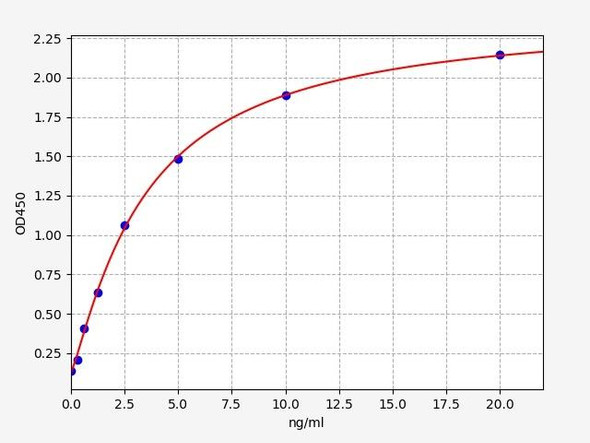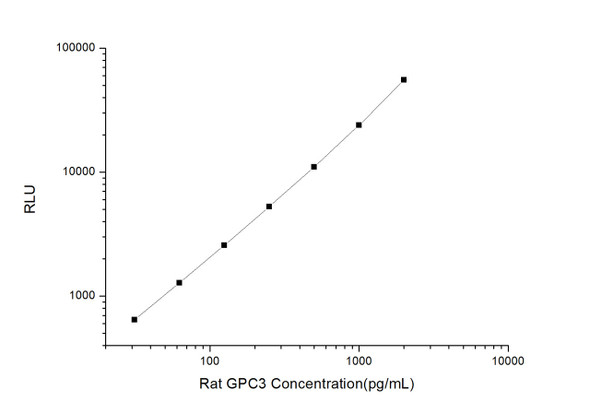Rat Signaling ELISA Kits 3
Rat NFIL-3 CLIA Kit (RTES00414)
- SKU:
- RTES00414
- Product Type:
- ELISA Kit
- ELISA Type:
- CLIA Kit
- Size:
- 96 Assays
- Sensitivity:
- 18.75pg/mL
- Range:
- 31.25-2000pg/mL
- ELISA Type:
- Sandwich
- Reactivity:
- Rat
- Sample Type:
- Serum, plasma and other biological fluids
- Research Area:
- Cell Biology
Description
| Assay type: | Sandwich |
| Format: | 96T |
| Assay time: | 4.5h |
| Reactivity: | Rat |
| Detection method: | Chemiluminescence |
| Detection range: | 31.25-2000 pg/mL |
| Sensitivity: | 18.75 pg/mL |
| Sample volume: | 100µL |
| Sample type: | Serum, plasma and other biological fluids |
| Repeatability: | CV < 15% |
| Specificity: | This kit recognizes Rat NFIL3 CLIA Kit in samples. No significant cross-reactivity or interference between Rat NFIL3 CLIA Kit and analogues was observed. |
This kit uses Sandwich-CLIA as the method. The micro CLIA plate provided in this kit has been pre-coated with an antibody specific to Rat NFIL3. Standards or samples are added to the appropriate micro CLIA plate wells and combined with the specific antibody. Then a biotinylated detection antibody specific for Rat NFIL3 and Avidin-Horseradish Peroxidase (HRP) conjugate are added to each micro plate well successively and incubated. Free components are washed away. The substrate solution is added to each well. Only those wells that contain Rat NFIL3, biotinylated detection antibody and Avidin-HRP conjugate will appear fluorescence. The Relative light unit (RLU) value is measured spectrophotometrically by the Chemiluminescence immunoassay analyzer. The RLU value is positively associated with the concentration of Rat NFIL3. The concentration of Rat NFIL3 in the samples can be calculated by comparing the RLU of the samples to the standard curve.
| UniProt Protein Function: | E4BP4: Acts as a transcriptional regulator that recognizes and binds to the sequence 5'-[GA]TTA[CT]GTAA[CT]-3', a sequence present in many cellular and viral promoters. Represses transcription from promoters with activating transcription factor (ATF) sites. Represses promoter activity in osteoblasts. Represses transcriptional activity of PER1. Represses transcriptional activity of PER2 via the B- site on the promoter. Activates transcription from the interleukin-3 promoter in T-cells. Competes for the same consensus-binding site with PAR DNA-binding factors (DBP, HLF and TEF). Component of the circadian clock that acts as a negative regulator for the circadian expression of PER2 oscillation in the cell-autonomous core clock. Protects pro-B cells from programmed cell death. Belongs to the bZIP family. NFIL3 subfamily. |
| UniProt Protein Details: | Protein type:DNA-binding; Transcription factor Cellular Component: nucleus Molecular Function:transcription factor activity Biological Process: transcription from RNA polymerase II promoter; circadian rhythm; immune response; negative regulation of transcription from RNA polymerase II promoter |
| NCBI Summary: | The protein encoded by this gene is a transcriptional regulator that binds as a homodimer to activating transcription factor (ATF) sites in many cellular and viral promoters. The encoded protein represses Per1 and Per2 expression and therefore plays a role in the regulation of circadian rhythm. [provided by RefSeq, Feb 2014] |
| UniProt Code: | Q6IMZ0 |
| NCBI GenInfo Identifier: | 48675850 |
| NCBI Gene ID: | 114519 |
| NCBI Accession: | NP_446179. 2 |
| UniProt Secondary Accession: | Q6IMZ0,Q923M2, |
| UniProt Related Accession: | Q6IMZ0 |
| Molecular Weight: | 50,781 Da |
| NCBI Full Name: | nuclear factor interleukin-3-regulated protein |
| NCBI Synonym Full Names: | nuclear factor, interleukin 3 regulated |
| NCBI Official Symbol: | Nfil3 |
| NCBI Official Synonym Symbols: | E4BP4 |
| NCBI Protein Information: | nuclear factor interleukin-3-regulated protein |
| UniProt Protein Name: | Nuclear factor interleukin-3-regulated protein |
| UniProt Synonym Protein Names: | E4 promoter-binding protein 4 |
| Protein Family: | Nuclear factor interleukin-3-regulated protein |
| UniProt Gene Name: | Nfil3 |
| UniProt Entry Name: | NFIL3_RAT |
As the RLU values of the standard curve may vary according to the conditions of the actual assay performance (e. g. operator, pipetting technique, washing technique or temperature effects), the operator should establish a standard curve for each test. Typical standard curve and data is provided below for reference only.
| Concentration (pg/mL) | RLU | Average | Corrected |
| 2000 | 54480 56962 | 55721 | 55693 |
| 1000 | 23603 24345 | 23974 | 23946 |
| 500 | 11094 10970 | 11032 | 11004 |
| 250 | 5044 5544 | 5294 | 5266 |
| 125 | 2798 2418 | 2608 | 2580 |
| 62.5 | 1378 1244 | 1311 | 1283 |
| 31.25 | 666 682 | 674 | 646 |
| 0 | 27 29 | 28 | -- |
Precision
Intra-assay Precision (Precision within an assay): 3 samples with low, mid range and high level Rat NFIL3 CLIA Kit were tested 20 times on one plate, respectively.
Inter-assay Precision (Precision between assays): 3 samples with low, mid range and high level Rat NFIL3 CLIA Kit were tested on 3 different plates, 20 replicates in each plate.
| Intra-assay Precision | Inter-assay Precision | |||||
| Sample | 1 | 2 | 3 | 1 | 2 | 3 |
| n | 20 | 20 | 20 | 20 | 20 | 20 |
| Mean (pg/mL) | 108.47 | 258.99 | 984.87 | 108.97 | 278.11 | 992.46 |
| Standard deviation | 13.27 | 27.19 | 104.49 | 12.35 | 28.12 | 86.34 |
| C V (%) | 12.23 | 10.50 | 10.61 | 11.33 | 10.11 | 8.70 |
Recovery
The recovery of Rat NFIL3 CLIA Kit spiked at three different levels in samples throughout the range of the assay was evaluated in various matrices.
| Sample Type | Range (%) | Average Recovery (%) |
| Serum (n=5) | 92-109 | 99 |
| EDTA plasma (n=5) | 86-99 | 93 |
| Cell culture media (n=5) | 89-105 | 96 |
Linearity
Samples were spiked with high concentrations of Rat NFIL3 CLIA Kit and diluted with Reference Standard & Sample Diluent to produce samples with values within the range of the assay.
| Serum (n=5) | EDTA plasma (n=5) | Cell culture media (n=5) | ||
| 1:2 | Range (%) | 102-119 | 93-109 | 99-115 |
| Average (%) | 110 | 101 | 105 | |
| 1:4 | Range (%) | 90-104 | 102-117 | 93-106 |
| Average (%) | 98 | 108 | 100 | |
| 1:8 | Range (%) | 101-115 | 98-109 | 96-109 |
| Average (%) | 107 | 103 | 102 | |
| 1:16 | Range (%) | 102-120 | 94-107 | 86-101 |
| Average (%) | 109 | 100 | 93 |
An unopened kit can be stored at 4°C for 1 month. If the kit is not used within 1 month, store the items separately according to the following conditions once the kit is received.
| Item | Specifications | Storage |
| Micro CLIA Plate(Dismountable) | 8 wells ×12 strips | -20°C, 6 months |
| Reference Standard | 2 vials | |
| Concentrated Biotinylated Detection Ab (100×) | 1 vial, 120 µL | |
| Concentrated HRP Conjugate (100×) | 1 vial, 120 µL | -20°C(shading light), 6 months |
| Reference Standard & Sample Diluent | 1 vial, 20 mL | 4°C, 6 months |
| Biotinylated Detection Ab Diluent | 1 vial, 14 mL | |
| HRP Conjugate Diluent | 1 vial, 14 mL | |
| Concentrated Wash Buffer (25×) | 1 vial, 30 mL | |
| Substrate Reagent A | 1 vial, 5 mL | 4°C (shading light) |
| Substrate Reagent B | 1 vial, 5 mL | 4°C (shading light) |
| Plate Sealer | 5 pieces | |
| Product Description | 1 copy | |
| Certificate of Analysis | 1 copy |
- Set standard, test sample and control (zero) wells on the pre-coated plate and record theirpositions. It is recommended to measure each standard and sample in duplicate. Note: addall solutions to the bottom of the plate wells while avoiding contact with the well walls. Ensuresolutions do not foam when adding to the wells.
- Aliquot 100µl of standard solutions into the standard wells.
- Add 100µl of Sample / Standard dilution buffer into the control (zero) well.
- Add 100µl of properly diluted sample (serum, plasma, tissue homogenates and otherbiological fluids. ) into test sample wells.
- Cover the plate with the sealer provided in the kit and incubate for 90 min at 37°C.
- Aspirate the liquid from each well, do not wash. Immediately add 100µL of BiotinylatedDetection Ab working solution to each well. Cover the plate with a plate seal and gently mix. Incubate for 1 hour at 37°C.
- Aspirate or decant the solution from the plate and add 350µL of wash buffer to each welland incubate for 1-2 minutes at room temperature. Aspirate the solution from each well andclap the plate on absorbent filter paper to dry. Repeat this process 3 times. Note: a microplatewasher can be used in this step and other wash steps.
- Add 100µL of HRP Conjugate working solution to each well. Cover with a plate seal andincubate for 30 min at 37°C.
- Aspirate or decant the solution from each well. Repeat the wash process for five times asconducted in step 7.
- Add 100µL of Substrate mixture solution to each well. Cover with a new plate seal andincubate for no more than 5 min at 37°C. Protect the plate from light.
- Determine the RLU value of each well immediately.

